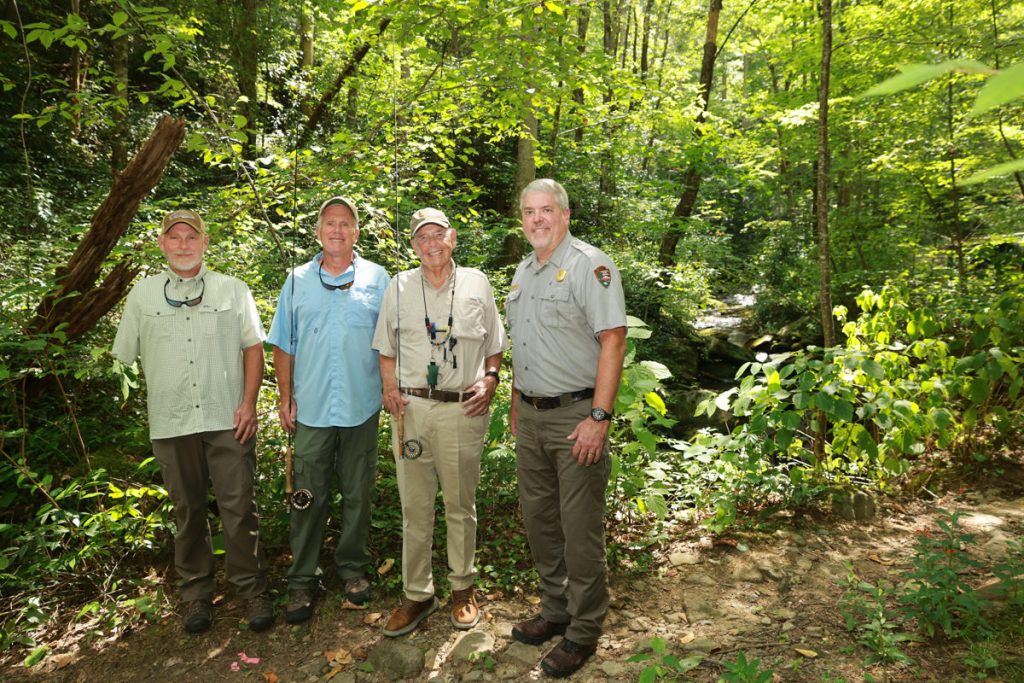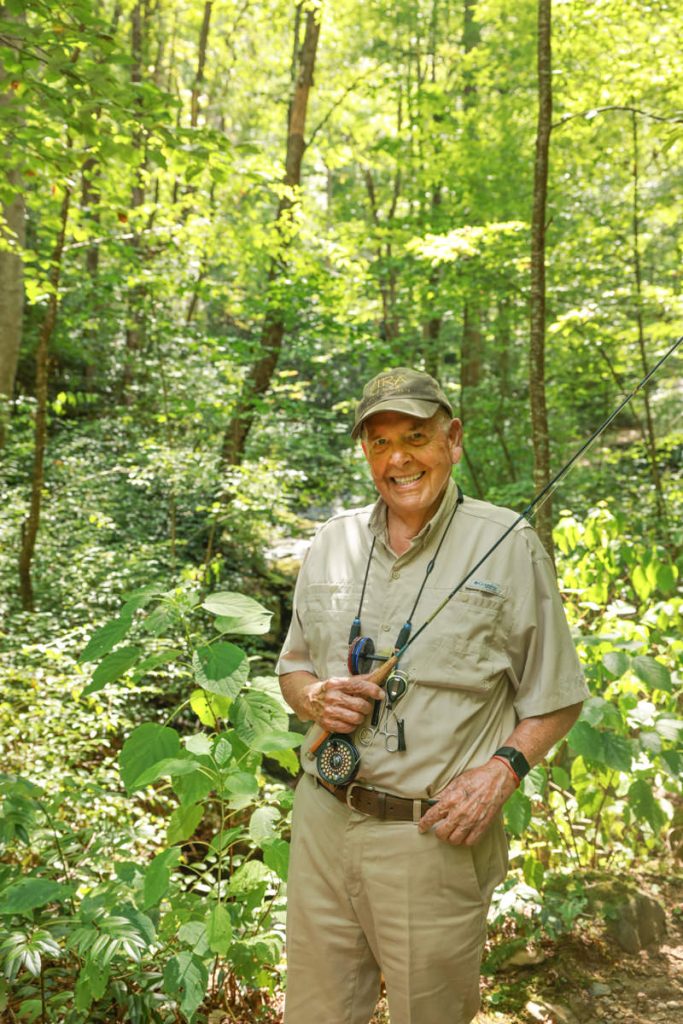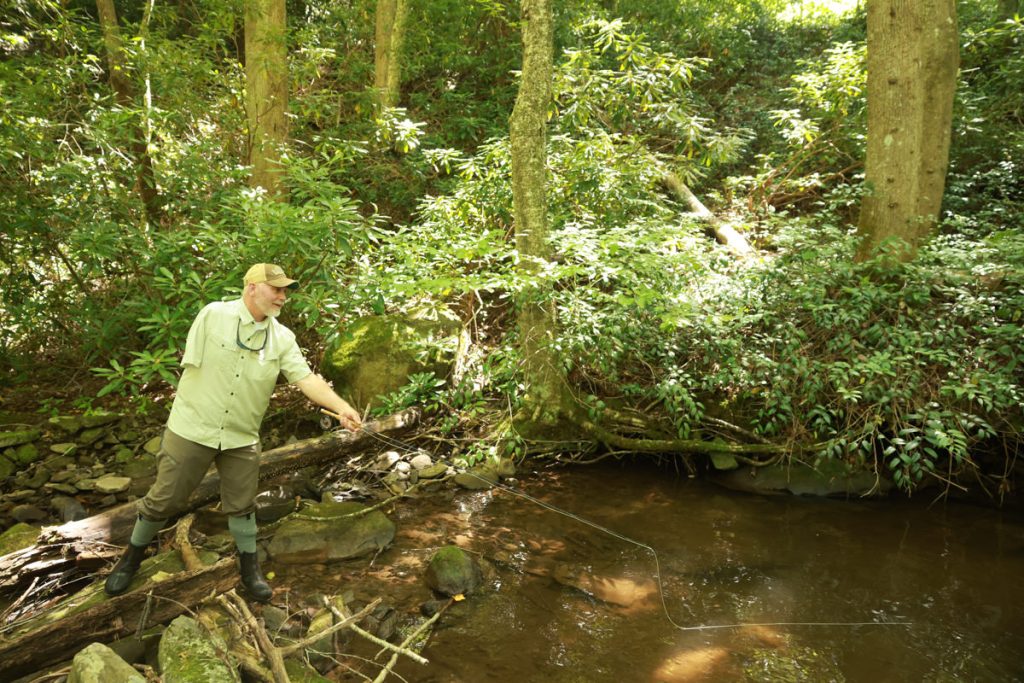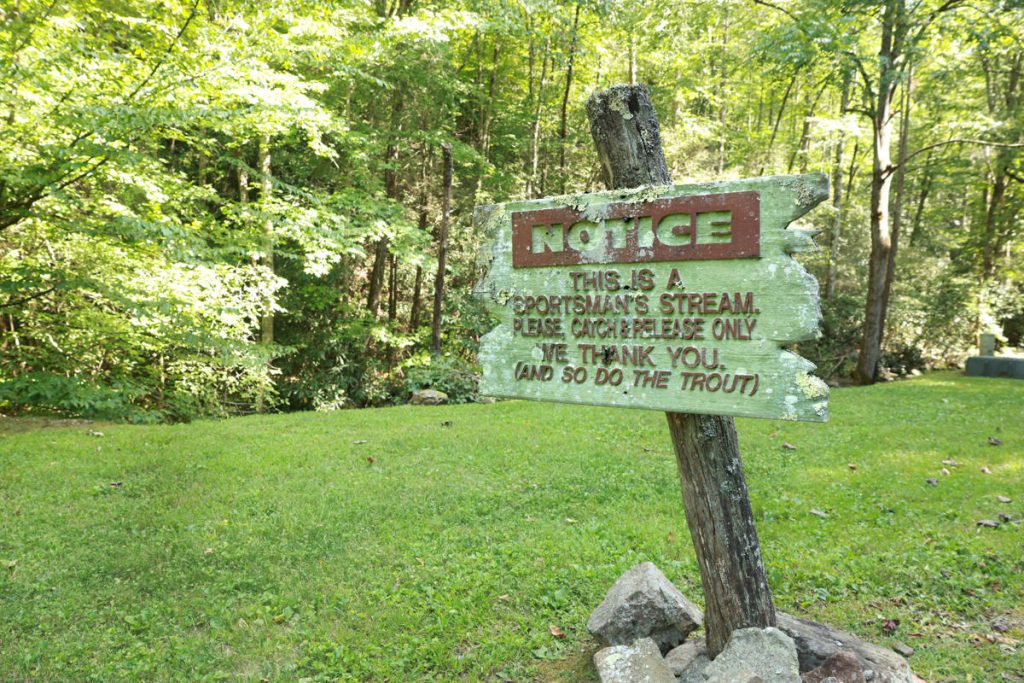There is no greater gift we leave than to help ensure the preservation of nature and our wildlife for future generations
It was the 75th annual Tennessee Wildlife Federation meeting in Chattanooga, and I sat next to Earl Worsham in the very spot TWF had held their first meeting. As part of the evening’s festivities, Earl was about to receive the award for Conservationist of the Year. The project he was being recognized for was the Brook Trout restoration project that he and his wife, Margit, brought to life on their property at Norton Creek near Gatlinburg. Sitting there that night I hoped that Earl and Margit would be willing to share their story.
“A roundtable,” I suggested to them, is how I would like to share this in the magazine. We’d talk about the Norton Creek trout project but also about conservation projects in our region as a whole. Both Earl and Margit were open to the idea, but insisted that we include the other voices that helped bring the brook trout project to fruition: Jim Habera, Region IV Fisheries Program Manager for the Tennessee Wildlife Resources Agency (TWRA), and Matt Kulp, Supervisory Fishery Biologist at the Division of Resource Management and Science for the Great Smoky Mountains National Park. We also invited Jason Maxedon, Executive Director of the TWRA to join us. And that is how I found myself with five conservationists, sitting on the porch at the main house on Norton Creek as the Brook trout swam without worry just down the hill from us.
Fishing is a hobby for some, but for Earl and Margit, it is a passion. Both have fished all over the world for countless varieties of species. But for many like them, the pursuit of trout ranks high on their list. And of all the trout species there is only one that is indigenous to this part of the world: the Appalachian Brook Trout.
The brilliant colors of this fish make it an instant favorite of many. So it is of little wonder to me that the curators of several miles of a private trout stream would want to do something to protect these living jewels of the mountains. One has to wonder exactly when and how the idea arose to protect this amazing resource. As we began our conversation it seemed the proper way to set the stage. So I asked what prompted the idea to protect and preserve this part of our heritage.

Earl Worsham: Margit is the real conservationist here. One day we were driving up the mountain. We got about a quarter way up, and it was one of those beautiful days. The sunshine was coming through the trees. I stopped the car, and Margit said, “You know, we ought to protect this property in some way, particularly along the road up through here, the drive to the mountain because as soon as we pass away, the kids are going to sell this place.” And so that started the very first conservation easement.
Nathan Sparks: So at Margit’s suggestion, the two of you decided to protect this space for future generations. Does the easement protect the brook trout conservation project property as well?
Margit Worsham: Yes, nobody’s ever allowed to build on it. The first easement is 237 acres. And we just put another 102 acres into a second conservation easement.
Earl Worsham: That protects the creek and the road and 200 feet on each side all the way up to the watershed where the water comes up.
Margit Worsham: We also have the synchronized fireflies so they’re protected by the same easement.
Nathan Sparks: Give me some history about how you became interested in creating this brook trout program.
Earl Worsham: I was the president of Trout Unlimited in Atlanta, and then I was on the national board for about 16 years and was the international chairperson. So I’m a fisherman, and then I bought this place, [Norton Creek]. Jim was working with the University of Tennessee, so we got the University of Tennessee and Georgia Wildlife and we wanted to get the Appalachian strain of Brook Trout, but we couldn’t get it because it was too early. They were just beginning a brook trout restoration program in the park. So I bought a lot of Brook Trout eggs, eyed, and a box called the Whitlock vibrant box. The box is an engineered plastic container that at the top of it you have 500 eyed eggs. It has slots in it, and as those eggs hatch out, they drop down into the bottom of the box. The bottom has engineered holes in it around the sides, so that when the egg sac of the small baby trout has been absorbed, they then swim out, and that keeps the predators from getting them so they’re strong enough to populate a creek.
With Jim and UT and volunteers, we put those boxes all up and down Norton Creek. We got a good population. Jim would come back and survey it every so often, and we’ve had a few reports from surveying those brook trout. Then about two years ago, I said, “I think the population has gone way down.” I wanted to put some more vibrant boxes in and hatch some eggs out, but it turns out that there was now a restriction on the Whitlock vibrant boxes. You had to have a proper program. So I called Jim and he said, “I think the National Park is ready to join the venture with this restoration program. And through the leadership of Matt Kulp and Jim Habera, we start this project, by first taking out the non-Appalachian trout by electro fishing.
Jim Habera: The process lasted over the course of the summer, it probably totaled up to five or six [passes]. We wanted to make sure we got them all.
Earl Worsham: Then instead of the eggs, we introduced basically what would be breeding pairs that were taken from three different watersheds in the park. They were placed in there, and we left them alone for a year.
Jim Habera: That next summer we came back to check and make sure they had spawned. And they did. We found reproduction throughout the area of that restoration zone. So we knew they had spawned that first fall, which is what we were hoping for. And then the summer of 2024, we came back and checked a couple sites, one down by the lower end and one up above that upper road crossing and the populations had multiple sizes and ages. So to my eye, they are very well-established now and they’re going to be there. It was great that you all had the foresight and vision to want to do that project and put those native fish back in there.

Earl Worsham: That was my objective from the beginning and now it’s somewhat of a reality.
Nathan Sparks: Matt, can you fill us in about the history of brook trout restoration in our area?
Matt Kulp: I started there in 1992 as a grad student, and I worked for Steve Moore who was the biologist at the time. Steve already had established a pretty robust brook trout restoration program…The park was kind of a haven for brook trout in its day. But from 1935 to 1975 the National Park actually stocked non native rainbow trout and brook trout. They stocked hatchery brook trout from the north, native to northeastern United States. So in the 70s they kind of realized the fault in their ways and ceased stocking. They came to find these rainbow trout were pretty invasive. I say all that to say it was really an advent in changing philosophy for the National Park Service.
Nathan Sparks: What did the restoration programs look like up until that point?
Matt Kulp: The park started some restorations that weren’t successful, some were just too ambitious, some didn’t have good barriers, a variety of reasons. When Steve Moore came on board, that’s when some of those were successful. His graduate work was on refining those techniques with electro-fishing. He got that program reinvigorated and started on a number of streams. We’ve moved into using chemical restoration using antimycin.
Nathan Sparks: Can you explain electro-fishing for those who don’t know?
Matt Kulp: It’s basically putting electricity into water and using that to stun the fish…It’s a nice tool for these mountain streams where it’s a pretty steep gradient, a lot of rocks and hard to get into with a seine or net.
Nathan Sparks: And then you take the non-native species and move them somewhere else.
Matt Kulp: That’s correct.
Nathan Sparks: Matt, how many streams in the park have been restored?
Matt Kulp: In total, we’re up to 19 streams now in the park and right at 39 to 40 miles restored.
Nathan Sparks: What’s a successful restoration look like?
Matt Kulp: Zero non-native species is your goal.
Nathan Sparks: How many fish constitute a reasonable population when they’ve reproduced for a few seasons?
Matt Kulp: It kind of depends on the stream. Each stream has a little bit different productivity and the biomass it’ll hold to support that population. So, it’d be about 1500 to 3,000 fish per mile. We have streams in the park that go up to five to 6,000 fish per mile, but each watershed has a different level of sustainability and some are just a lot more productive than others.
Jim Habera: In a typical size stream I’ve always thought a really good high density, above-average brook trout population is about a fish per meter. So if we do 100 meters sample site, and we end up with 100 brook trout out of that all ages and all sizes, that’s kind of above average.
Nathan Sparks: What is the population like here in Norton Creek?
Jim Habera: We actually did quantitative samples back in June. Just to my looking at the numbers, we got the lower site down just above the switchback and I think there were 80 fish in that site. That would be above average. It looked really good. And then on the upper end, the habitat’s a little smaller up there, so not quite that many fish, but still average to above an average brook trout population, abundance wise, in size, structure, age class, to what you’d see elsewhere in the mountains of East Tennessee.
Nathan Sparks: This is the project you got an award from the Tennessee Wildlife Federation for, correct?
Earl Worsham: For the brook trout restoration, yes. And I didn’t even do anything. (chuckles) These guys did all the work and a fabulous job.
Jim Habera: We took those trout out in the summer and early fall of 2021 and then translocated those fish from the three park streams in September 2021. We let that set for the next year or so…We did come back in the summer of 2022 just to poke around a little bit, make sure that we saw some reproduction just to make sure, did we get these fish in here in time? Did they find each other to spawn? And they sure did.
Earl Worsham: I was worried about it because I feed the fish down below the rainbow trout below the waterfall, and they put in the pool house. The pool house, by the way, is a reservoir for electro generating, hydro generation for the power for the main house. That’s what it was before. The brook trout restoration is from the pool house up until the full watershed so it’s protected from the rainbow trout by a large waterfall.

Nathan Sparks: So the waterfall acts as a natural barrier keeping the rainbows in the lower creek from migrating upstream. Or at least that is the intention, correct?
Matt Kulp: I think we are pretty safe unless they have wings.
Earl Worsham: It’s kind of interesting. When we did the first projects in the 1990s with the University of Tennessee and Tennessee Wildlife [Resources Agency] and Georgia Wildlife, we would put in these eggs, go through the Whitlock vibrant boxes and hatch them out and let them breed and so reproduce in the creek. I invited my good friend up from Knoxville who’s a fly fisherman, his nickname is Panther, saying, “Panther, this is pristine brook trout water that you’re going to be fishing.” And the first two fish he caught were rainbow, but we got them all out this time.
Nathan Sparks: Jason, can you talk about TWRA’s role in conservation efforts like this?
Jason Maxedon: Conservation doesn’t happen without partnerships. We have many great federal partners, many great state partners, but the most critical partners are on private land, because 90 percent of our state is in private ownership, and so we dream about partners like Earl and Margit. What they’ve done is a legacy. It’s a legacy for them now, but it’s a legacy for future generations. And what they’ve done by putting the property into a conservation easement, that’s going to carry on, and what they’ve done with the brook trout is going to carry on. It’s going to get a native population that we can work with them on, and hopefully folks that have the conservation easement in the future to be able to move those fish to other areas, to keep those native populations. So it’s a great thing for our state. It’s a great thing for all of our partners, and we’re very thankful for what you’ve done.
Nathan Sparks: Matt, is it true that this species of brook trout only exists in this end of the state?
Matt Kulp: That’s correct.
Nathan Sparks: I am aware that there is a size limit, but are they protected in any other way?
Matt Kulp: Of course. The park has a seven inch size limit on the fish and a five fish daily crew limit. And then the state has different regulations outside the park.
Nathan Sparks: My understanding is that most that seek the thrill of catching a brookie are catch and release sportsman, do you find that to be the case?
Jim Habera: We’ve tried different regulations over the years, but over time, came to the realization it’s not really necessary to have really restrictive regulations on them. They are a GCN species in Tennessee, greatest conservation need. They’ve got to have this really particular habitat, these cold water streams up in the higher elevations in the mountains. But they’re not so unabundant that we can’t just manage them with some basic angling regulations. We used to have a six inch size limit outside the park and decided that wasn’t even necessary. The angling pressure on them these days is so low. The people that seek out those waters to fish for brook trout, are not interested in harvesting those so it became apparent to us it wasn’t necessary to have a lot of regulations on them. If that were to ever change, we could go that route. But at this time, it doesn’t appear to be necessary. It takes effort to catch a brook trout. It does. You’ve got to want to do it. You have to want to go to where they live.
Nathan Sparks: Talk to me about TWRA’s stocking programs across the state.
Jason Maxedon: Our agency stocks about 9 million fish a year across the state. We stock a lot of panfish. We’ve got bass, bluegill, crappie, trout, and many other species.
Jim Habera: Giant walleye, sauger, striped bass, hybrid striped bass, Florida bass now, or f1 hybrids—that’s been big in some areas now and has become real popular.

Nathan Sparks: Break that down for me a little bit please. How many of those are trout for East Tennessee?
Jim Habera: In East Tennessee, it’s over a million trout, just in East Tennessee. And that doesn’t even count the warm water and cool water species…We have two trout hatcheries in region four in East Tennessee, one in Irwin and then Buffalo Springs which flows into the Holston near Blaine, is our big one. It’s actually a true hatchery, where they bring in rainbow trout eggs every year and hatch those. And that hatchery not only supplies fish to a lot of the seasonal trout streams and some tailwaters and reservoirs in East Tennessee, but they also provide the starter fish, the grow out fish for the Irwin hatchery, and also for Gatlinburg. Buffalo Springs provides most of the trout that are stocked, ultimately by the Gatlinburg hatchery.
Jason Maxedon: One interesting thing that we do with some of those fish as well is like we are even out in West Tennessee, where you got cooler water temperatures in the winter months. We’ll go out and have little sections that we may stock in a lake for what we call R3—recruitment, retention and reactivation. We’re trying to get folks into angling that may not have that opportunity, and it’s a good opportunity to allow them in those winter months to actually catch the trout even out in West Tennessee.
Earl Worsham: Matt, in the park is it catch and release or can you harvest any trout?
Matt Kulp:You can harvest them over seven inches, five per day. Less than four percent get over seven inches in most streams.
Nathan Sparks: So there’s no harvest effectively happening?
Matt Kulp: Not really. Brook trout fishing was closed in the park up until the early 2000s. Prior to that, we did a little study to evaluate fishing and harvest in the park, and it was an 87 percent of the people fish and catch and release on their own. And so even if they caught legal sized fish, they answered they would throw them back anyway. So I think it’s the type of people that seek those types of opportunities, as we were talking about, they’re just there for the experience, and not there necessarily to harvest fish.
Jason Maxedon: Let me back up. That is to harvest fish. Some of what we do is workshops to recruit these folks into it. We’re doing things like where we teach them what baits to throw, how to catch these fish, how to clean them, how to cook them. So we’re trying to get folks into fishing that have never done it before, and carry it all the way to the table.
Nathan Sparks: Which promotes license sales, which is how you’re funded.
Jason Maxedon: That is correct. We want to promote sales.
Nathan Sparks: Why does the state not fund you directly?
Jason Maxedon:That’s a model that was set up back in 1949 by Governor Gordon Browning. Right now, we’re primarily funded by the sale of hunting and fishing licenses. It’s a model that’s worked for a long time for many states, but it’s not working as well for a lot of states now. The reason it’s not working as good is we’re not selling as many hunting and fishing licenses. Folks have changed a lot. A lot of people were taking kids and grandkids, and that’s not happening as much now. So we’re constantly trying to work through the R3 effort to try to do that. We do get some money from the state and that’s very important to us. We get a portion of the real estate transfer tax, about three-and-a-quarter percent on 100 is what we get. That’s critical to us. We typically use that money to purchase lands with and to do some maintenance on some of our wildlife management areas and hatcheries. The other biggest part of our funding comes in from Pittman Robertson dollars, which is a Federal excise tax, [a tax] put on the manufacturer of safe firearms, and it gets passed on eventually to the consumer, but they pay that. That’s big money to us, to the tune of anywhere from $20 to $25 million a year, and that’s where these partnerships are critical. We can take that money and match things like with the University of Tennessee. If we wanted to do a research project, we typically will take 75 percent of Pittman Robertson dollars, and the university will put up 25 percent and that’s the way we do a lot of research. It’s where we work with a lot of different partners. You mentioned the Tennessee Wildlife Federation a minute ago. We grant them funds to run a couple of their programs with those Pittman Robertson dollars. So those are critical dollars. With that funding model, the states that are really being successful right now, that aren’t having money issues for that model, are states that have a portion of a sales tax that usually like 1/8 of 1 percent of an existing tax on sporting goods in their state. Those are the states that are doing the best right now.
The conversation continued over lunch. Before we feasted on Margit’s fabulous cooking, Matt reminded us that it is unique for the park to get involved in a project on private land. They made an exception here primarily because of the permanent easement that protects Earl and Margit’s property and this project in perpetuity.
The other part of this is establishing a part of the genotype that we didn’t have anywhere else but in the park. Now they have those fish in another place, in case they ever have to draw upon those for sources. During our conversation, Earl had likened this to a “brook trout gene bank.” Whatever the reasons, it is good to see active conservation projects in our backyard.
Later that afternoon, Earl and Margit took us down to lower Norton Creek, where we have fished many times before. We all tried our hand. Ultimately, it was my son Ethan, who joined us to film this discussion, who landed the best fish of the day. I’m glad to be part of keeping this tradition alive in our region with my own family, and thank Earl and Margit, the TWRA, and the National Park Service for the role they’ve played to keep this past-time alive and these trout populations thriving in Appalachia.

Comments are closed.